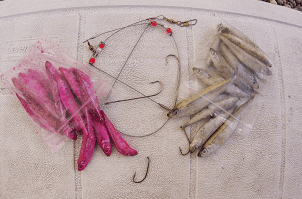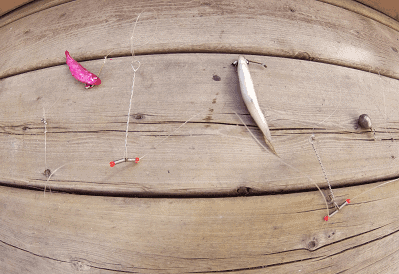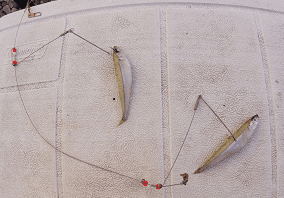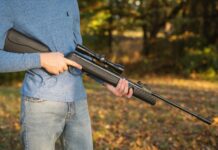
Rigging dead bait to catch pike is one of the more popular methods used to catch these fish. When northern pike just won’t rise for spoons or crankbait using bait fish can be a great way to land a few fish. There are a number of different methods depending on the technique you are using from bottom fishing, float fishing, casting, trolling or even ice fishing.
Table of Contents
Pickerel Rig
This is probably one of the best known and most commonly used dead bait rigs for pike and also walleye. Very inexpensive ( a few dollars) and hardy, you will land a number of fish with one before needing to replace it. These rigs consist of a length of monofilament a few feet long with two steel arms to hold the bait away from the mainline.
At the top is a barrel swivel with bearings to stop line twist. Below that are the two metal arms, these also incorporate red beads as a way to attract the pike’s attention. A snelled hook on a short (4 inch or so) monofilament leader is then added off these arms.

Lastly on the very bottom is a snap to add fishing sinkers. This makes it great to use in lakes or even targeting a pocket of water in faster moving rivers where pike may be hunting.
I use the pickerel rig a lot as a dead bait rig for pike both in open water and ice fishing season. I will often use two different baits on them. Something like an anchovy on one and then a green or yellow smelt on the other.
Quick Strike Rigs
The quick strike rig consists of two or three treble hooks with monofilament leader. The commercially available rigs can have a wire leader instead. In there most basic form you can just make your own with the leaders going up to a central loop. Additionally you can add red beads as an extra visual attractant. A barrel swivel at the top is also a good idea as pike love to roll after they feel a hook set.

I have used quick strike rigs for a few years now when ice fishing with tip ups and, they are absolutely deadly. My usual tactic is to use a much larger bait such as an 8 inch herring, looking to land a solid 3 foot+ northern pike.
Jackfish Rig
Jack fish rigs are quite similar to Pickerel rigs. Instead of the monofilament leaders holding the hooks in this case there is a solid steel leader. Jackfish Riggs still incorporate the red beads to help attract pike. These rigs normally have larger hooks then the pickerel rigs. Another thing I will do with a jack fish rig is swap out one of the hooks for a jig head.I find yellow or green jig heads particularly effective in this case. There is a little spring holding the hook in place on a jack fish rig that makes this modification quick and easy.
Snelled Hooks
Standard snelled hooks will work fine for applications such as float fishing. Suspending a deadbeat underneath the float is ideal for some situations such as heavily weeded areas where you don’t want to get snagged constantly. Also can be good if you know fish are holding in a certain depth. This will work with a standard bobber and with a slip bobber.
Big is ok as far as hook size is concerned. For decent-sized smelt and anchovy try a 2/0 or 3/0 size snelled hook. If the pike are only small hammer handles ( 12 or 16 inch fish) you may want to downsize a bit and go with a 1 or 1/0 size hook. Again this will depend on your bait size as you don’t want a massive hook for small shiners.
Rigging Jig Heads with a Minnow
I’ll often use just a standard jig head paired with a dead bait instead of a soft bait. This technique will work great with anchovies or colored smelt. I seem to have great success with yellows and greens. There are even jig heads with a small propeller that seems to work well if you’re moving them in the water for extra Flash.
You have to make sure to use a steel leader when using a jig head. Pike are notorious for severing through fishing line.
Tipping Spoons with a Minnow
Another great way Of using dead bait is tipping the end of your artificial lure with a small piece of bait fish. A small piece of belly meat from a bait fish added to a spoon introduces scent to an already flashy presentation.
Related Products
Frequently Asked Questions
Can you use “Bait” from the Grocery Store?
The grocery store is great place to get bulk bait fish to use as pike bait. You can often get several times more smelt or anchovies for the same price as a package from your local bait shop.
Can Pike Smell?
They can indeed, pike will follow a scent trail a fair ways underwater. Their sense of smell is not as well developed as some species. For this reason its good to use high oil bait fish. I prefer anchovy for this reason. During ice fishing season I will thaw anchovy overnight in a Ziploc bag to make them extra juicy and stinky.
Pike will eat carrion naturally so smelly dead fish is their thing. If you are going for larger pike consider a much larger dead bait on a quick strike rig. Herring are a good choice for this again as they are an oiler fish.
Some people will also catch and freeze suckers for this purpose also. Suckers arnt considered game fish so you should be fine to do this in your state or province. As always its smart to consult your local fishing regulations about this.
How do you make Dead Bait Rigs for Pike?
You can easily make a quick strike rig for pike fishing with dead bait. In its simplest form all you need is a few feet of monofilament and a few treble hooks. The exact size will vary depending on the bait fish you are rigging from smelt all the way up to foot long white sucker fish.
I personally will have one side of the rig shorter than the other. This will ensure a “head down” presentation as most fish take bait fish head first. I also tend to go with smaller treble hooks for my quick strikes. Some people also add a third treble hook to the rig, if the regulations in that jurisdiction allow .
Should Dead Bait Hang Horizontally or Head Down ?
When you were rigging a dead bait for Pike with a quick strike rig you have a couple of options on how to orient the bait. A very popular way is to make sure your folks are set of equal length so the bait hangs horizontally in the water. Another popular option is with a shorter leader on the dorsal hook and a longer one on the head hook so that your bait will hang head down in the water. Many fish will take a bait head first which is why this is also advantageous.
Pike will eat carrion naturally so smelly dead fish is their thing. If you are going for larger pike consider a much larger dead bait on a quick strike rig. Herring are a good choice for this again as they are an oiler fish.
Some people will also catch and freeze suckers for this purpose also. Suckers arnt considered game fish so you should be fine to do this in your state or province. As always its smart to consult your local fishing regulations about this.” } },{ “@type”: “Question”, “name”: “How do you make Dead Bait Rigs for Pike?”, “acceptedAnswer”: { “@type”: “Answer”, “text”: “You can easily make a quick strike rig for pike fishing with dead bait. In its simplest form all you need is a few feet of monofilament and a few treble hooks. The exact size will vary depending on the bait fish you are rigging from smelt all the way up to foot long white sucker fish.
I personally will have one side of the rig shorter than the other. This will ensure a “head down” presentation as most fish take bait fish head first. I also tend to go with smaller treble hooks for my quick strikes. Some people also add a third treble hook to the rig, if the regulations in that jurisdiction allow .” } },{ “@type”: “Question”, “name”: “Should Dead Bait Hang Horizontally or Head Down ?”, “acceptedAnswer”: { “@type”: “Answer”, “text”: “When you were rigging a dead bait for Pike with a quick strike rig you have a couple of options on how to orient the bait. A very popular way is to make sure your folks are set of equal length so the bait hangs horizontally in the water. Another popular option is with a shorter leader on the dorsal hook and a longer one on the head hook so that your bait will hang head down in the water. Many fish will take a bait head first which is why this is also advantageous.” } }] }











































